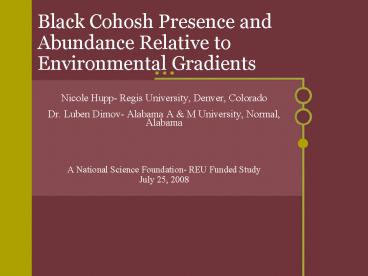Black Cohosh Presence and Abundance Relative to Environmental Gradients - PowerPoint PPT Presentation
1 / 17
Title:
Black Cohosh Presence and Abundance Relative to Environmental Gradients
Description:
Black Cohosh Presence and Abundance Relative to Environmental Gradients Nicole Hupp- Regis University, Denver, Colorado Dr. Luben Dimov- Alabama A & M University ... – PowerPoint PPT presentation
Number of Views:80
Avg rating:3.0/5.0
Title: Black Cohosh Presence and Abundance Relative to Environmental Gradients
1
Black Cohosh Presence and Abundance Relative to
Environmental Gradients
- Nicole Hupp- Regis University, Denver, Colorado
- Dr. Luben Dimov- Alabama A M University,
Normal, Alabama - A National Science Foundation- REU Funded Study
- July 25, 2008
2
What is black cohosh?
- Black cohsoh (Actea racemosa) is a hardy
perennial native to eastern and southeastern
United States and southern portion of Canada - Typically found at about 1-3 feet in height
- Contains bolts (flowering structures)
- Strong, distinct odor
3
The significance of black cohosh
- Known for its medicinal properties
- Historically used to treat a variety of issues
- Currently used by women in the US and Europe for
relief from menopausal complaints - Perhaps a safer alternative to hormone
replacement therapy
4
Study Relevance
- Due to increase in popularity over the last
decade, value of black cohosh has increased - Price peaked in 2000 at 14-17/lb. (ASI, 2001)
- Nearly 97 of black cohosh used harvested from
the wild (Lyke, 2001) - No quantitative studies on its ecological
requirements
5
Objectives
- Determine the relationship between
- black cohosh abundance and flowering performance
- environmental variables
- Test hypotheses indicated by other studies
concerning black cohosh habitat
6
Hypotheses
- Black cohosh plot cover is not related to the
studied environmental variables, including canopy
cover, tree basal area, stand stocking, and soil
moisture - Black cohosh will be found only on northeast
facing slopes that are well drained and
significantly shaded
7
Site Description
- Plots established in Jack Gap, Jackson County, AL
(Cumberland Plateau) (34 56' 19.6434" N, 86 5'
8.0658) - Located on escarpments of plateau with deep,
loamy soils that have moderately low fertility
and are well drained (Smalley, 1982) - Most slopes range from 15 to 30 percent (Smalley,
1982)
8
Methods
- We used systematic sampling by establishing
transects along elevation gradient of the plateau
escarpment - We selected circular plots (r5 m, plot area78.5
m2) located at points along transects that
contained black cohosh - Locations visible from but
- not on transects were
- studied if we encountered
- black cohosh in them
9
Statistical Analysis
- Only basic statistical methods were used up to
this point - Reported is only minimum, maximum, mean, standard
deviation, and preliminary multiple linear
regression results - We will carry out more complex analysis with
multiple linear regression and non-parametric
ordination
10
Dependent Variables
- Black cohosh plot cover
- Number of bolts (flowering structures) on the
plot
11
Environmental Characteristics Studied
- Microtopography
- Soil ph
- Percent soil moisture
- Aspect
- Tree basal area
- Photosynthetically Active Radiation
- Slope
- Canopy cover
12
Results
- Only basic statistics reported at this time more
complex analysis is being performed
Standard Dev Average Minimum Maximum
Cohosh Cover (m2/plot) 5.65 4.93 0 29
Cohosh Plants/plot 16.61 17.6 0 58
Number Flowering Bolts/plot 5.82 4.24 0 25
Basal Area (ft2/ac) 29.5 103.91 20 170
Percent Open Canopy North 3.12 5.93 1.04 14.56
Percent Open Canopy South 3.81 7.05 4.04 15.6
Percent Open Canopy East 3.92 7.42 1.04 15.6
Percent Open Canopy West 3.22 5.57 1.04 16.64
Total Percent Open Canopy 5.00 7.17 2.6 34.06
Aspect Adjust w/ Beers 0.75 0.74 0.00 2
13
Results
Regression with number of bolts as the dependent
variable and aspect as predictor
Regression with cohosh cover as dependent
variable and slope as predictor
14
Discussion
- Black cohosh has been previously reported to only
be found on northeastern facing slope - We found it to be more of a generalist
- Beneficial knowledge for those wanting to plant
or harvest black cohosh from the wild
15
Future Research
- Further explore relationships between black
cohosh and environmental characteristics - Use multiple linear regression
- Consider non-linear relationships and ordination
techniques to see relationship of predictors and
amount of cohosh and number of flowering bolts
16
Interesting Facts
- On several plots black cohosh was found under
black walnut despite allelopathic effects - American chestnut occurrence
17
Acknowledgements
- Dr. Luben Dimov
- National Science Foundations REU Grant
- Alabama A M University
- USDA Forest Service
- Regis University
- The State of Alabamas Department of Conservation
and Natural Resources - Dawn Lemke
- Lynne Weninegar
- Dr. Yong Wang































